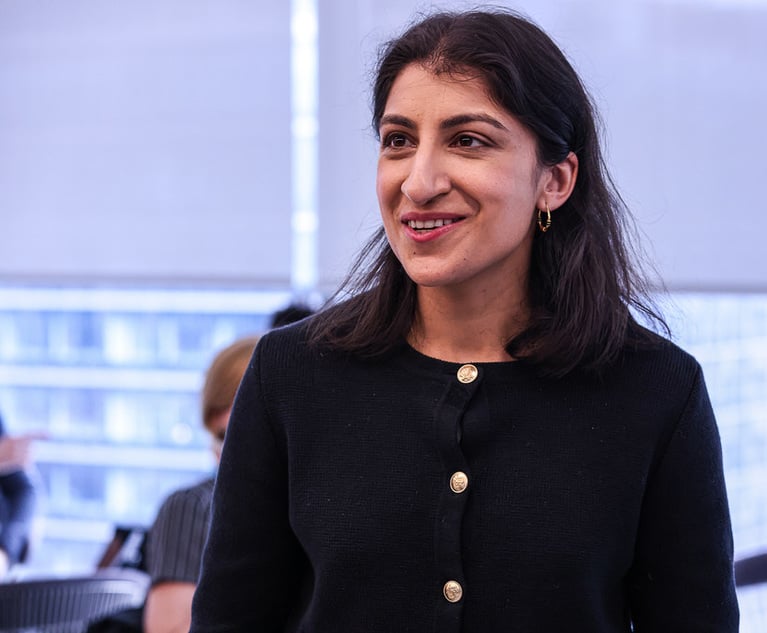Litigation Finance & Insurance: 5 Tips to Securing the Best Funding Terms
Corporate litigation finance is still a relatively new phenomenon in the United States, but it is rapidly gaining prominence. Once perceived as relevant…
September 19, 2017 at 11:46 AM
6 minute read
The original version of this story was published on Law.com
Corporate litigation finance is still a relatively new phenomenon in the United States, but it is rapidly gaining prominence. Once perceived as relevant only to the financially weaker party in 'bet the company' litigation, there are now countless examples of major corporations with strong balance sheets recognizing the benefits of using non-recourse litigation finance, structured either around a single claim or a litigation portfolio.
To be able to present the possibility of litigation finance to the board, general counsel will invariably have questions about how it works, what is available, its benefits, its pitfalls and best practices for considering and obtaining funding.
In the first of this 3-part series, we present our top 5 tips for securing the best funding terms possible from the market.
- 1. Dress the shop window
Once the decision is made to seek outside finance, the first question is often how best to present the opportunity to the litigation funding market. The approach taken to case presentation will have a significant bearing on the chances of obtaining offers and the speed with which the process can be completed.
Every funder is different, but most are essentially looking for the same basic ingredients: the case must have good merits with a healthy margin between the realistic (recoverable) damages and the level of financing requested. Therefore, the case presentation should enable the funder to quickly form a preliminary view on the case and either make an offer or walk away.
While this may sound simple, in practice it can be a minefield. Providing too little can significantly slow down the process and encourage funders to pass on the opportunity without fully understanding the issues. On the flip side, while recent court decisions have generally been helpful, counsel will nevertheless rightly be wary of sharing too much sensitive and strategic information, which could be highly damaging to the case if the privilege was somehow lost.
- 2. Be objective about the case and likely outcomes
Most funders tend to be cautious and apply highly conservative assumptions when analyzing cases. While every opportunity should be taken to “sell” the case, funders may not respond well to unrealistic or overly ambitious statements about the case and likely outcomes.
Maintaining a measured and commercially rational outlook on the case is also helpful when considering different funding options. Some funders may be willing to trade lower returns in very high settlement outcomes in exchange for a larger share of a lower recovery. While the temptation is often to focus on the big numbers, considering how the funding terms will wash out in modest to mid-range damages outcomes is equally important in order to avoid retrospective shareholder dissatisfaction with a funding deal post-settlement.
- 3. Know the market and shop around
This is our most important tip of all. While some generalizations can be drawn with respect to what most funders will look for or avoid when financing cases, in practice the global litigation finance market is diverse. Finance providers' appetites, investment criteria, underwriting and due diligence process, speed of execution, subject matter and jurisdictional expertise and approach to pricing are all highly variable, meaning any given opportunity may be turned down by some funders, while being actively pursued by others.
Careful and informed funder selection will give the best chance of obtaining multiple offers of funding, which in turn is the key to securing the best funding terms. Even relatively small differences between pricing and return structures can increase the claim holder's net recovery by millions or tens of millions of dollars; and the larger the case, the greater the dollar impact.
Multiple competing funding offers will also significantly increase a plaintiff's bargaining position. Being the only show in town enables a funder to adopt a 'take it or leave it' approach to negotiations, whereas creating a competitive process enables general counsel to push harder to improve the commercial terms offered.
- 4. Avoid a one-dimensional approach
At its most basic, litigation finance is a relatively simple arrangement involving the provision of capital in exchange for a share of any claim proceeds. However, interesting recent developments in this space have included the emergence of sophisticated alternative litigation finance structures and products.
Examples include the expansion of the litigation insurance market, well-established in Europe and now gaining ground in North America. Corporate plaintiffs for whom risk management, as opposed to liquidity, is the main driver now increasingly consider insurance as a way of achieving a similar risk hedge to litigation finance, but without having to pay the high levels of return required by litigation funders.
Another area in which the litigation finance market is developing is the growing emphasis on portfolio financing, where the funding is structured not around a single claim, but cross-collateralized across a litigation portfolio. Portfolio financing will be touched upon later in the series, but for corporates that are simultaneously involved in multiple disputes, portfolio finance, if structured correctly, can offer useful efficiencies and a lower cost of capital.
- 5. Waterfall is as important as return
What share of any damages recovered flows to the funder will be determined both by the funder's return / success fee pricing, and by the waterfall or priority agreement (which sets out how the recoveries at various levels are to be apportioned between the litigation “stakeholders”, such as claim holder, funder, insurer, law firm or other investors or interested parties).
The waterfall should provide a fair reflection of the investment or contribution of each stakeholder and avoid any misalignment of incentives. When negotiating funding, the waterfall is a key component in seeking the best deal.
James Blick, principal of TheJudge and head of its U.S. operations, arranges litigation finance and insurance solutions. Erika Levin, Esq., is a senior vice president at TheJudge and specializes in litigation and arbitration as well as international business transactions.
This content has been archived. It is available through our partners, LexisNexis® and Bloomberg Law.
To view this content, please continue to their sites.
Not a Lexis Subscriber?
Subscribe Now
Not a Bloomberg Law Subscriber?
Subscribe Now
NOT FOR REPRINT
© 2025 ALM Global, LLC, All Rights Reserved. Request academic re-use from www.copyright.com. All other uses, submit a request to [email protected]. For more information visit Asset & Logo Licensing.
You Might Like
View All
What to Know About the New 'Overlapping Directorship' Antitrust Development
4 minute read
Turning Over Legal Tedium to AI Requires Lots of Unglamorous Work on Front End
6 minute read
Khan Defends FTC Tenure, Does Not Address Post-Inauguration Plans

Best Practices for Adopting and Adapting to AI: Mitigating Risk in Light of Increasing Regulatory and Shareholder Scrutiny
7 minute readTrending Stories
- 1Litigators of the Week: A Knockout Blow to Latest FCC Net Neutrality Rules After ‘Loper Bright’
- 2Litigator of the Week Runners-Up and Shout-Outs
- 3Norton Rose Sues South Africa Government Over Ethnicity Score System
- 4KMPG Wants to Provide Legal Services in the US. Now All Eyes Are on Their Big Four Peers
- 5Friday Newspaper
Who Got The Work
Michael G. Bongiorno, Andrew Scott Dulberg and Elizabeth E. Driscoll from Wilmer Cutler Pickering Hale and Dorr have stepped in to represent Symbotic Inc., an A.I.-enabled technology platform that focuses on increasing supply chain efficiency, and other defendants in a pending shareholder derivative lawsuit. The case, filed Oct. 2 in Massachusetts District Court by the Brown Law Firm on behalf of Stephen Austen, accuses certain officers and directors of misleading investors in regard to Symbotic's potential for margin growth by failing to disclose that the company was not equipped to timely deploy its systems or manage expenses through project delays. The case, assigned to U.S. District Judge Nathaniel M. Gorton, is 1:24-cv-12522, Austen v. Cohen et al.
Who Got The Work
Edmund Polubinski and Marie Killmond of Davis Polk & Wardwell have entered appearances for data platform software development company MongoDB and other defendants in a pending shareholder derivative lawsuit. The action, filed Oct. 7 in New York Southern District Court by the Brown Law Firm, accuses the company's directors and/or officers of falsely expressing confidence in the company’s restructuring of its sales incentive plan and downplaying the severity of decreases in its upfront commitments. The case is 1:24-cv-07594, Roy v. Ittycheria et al.
Who Got The Work
Amy O. Bruchs and Kurt F. Ellison of Michael Best & Friedrich have entered appearances for Epic Systems Corp. in a pending employment discrimination lawsuit. The suit was filed Sept. 7 in Wisconsin Western District Court by Levine Eisberner LLC and Siri & Glimstad on behalf of a project manager who claims that he was wrongfully terminated after applying for a religious exemption to the defendant's COVID-19 vaccine mandate. The case, assigned to U.S. Magistrate Judge Anita Marie Boor, is 3:24-cv-00630, Secker, Nathan v. Epic Systems Corporation.
Who Got The Work
David X. Sullivan, Thomas J. Finn and Gregory A. Hall from McCarter & English have entered appearances for Sunrun Installation Services in a pending civil rights lawsuit. The complaint was filed Sept. 4 in Connecticut District Court by attorney Robert M. Berke on behalf of former employee George Edward Steins, who was arrested and charged with employing an unregistered home improvement salesperson. The complaint alleges that had Sunrun informed the Connecticut Department of Consumer Protection that the plaintiff's employment had ended in 2017 and that he no longer held Sunrun's home improvement contractor license, he would not have been hit with charges, which were dismissed in May 2024. The case, assigned to U.S. District Judge Jeffrey A. Meyer, is 3:24-cv-01423, Steins v. Sunrun, Inc. et al.
Who Got The Work
Greenberg Traurig shareholder Joshua L. Raskin has entered an appearance for boohoo.com UK Ltd. in a pending patent infringement lawsuit. The suit, filed Sept. 3 in Texas Eastern District Court by Rozier Hardt McDonough on behalf of Alto Dynamics, asserts five patents related to an online shopping platform. The case, assigned to U.S. District Judge Rodney Gilstrap, is 2:24-cv-00719, Alto Dynamics, LLC v. boohoo.com UK Limited.
Featured Firms
Law Offices of Gary Martin Hays & Associates, P.C.
(470) 294-1674
Law Offices of Mark E. Salomone
(857) 444-6468
Smith & Hassler
(713) 739-1250






